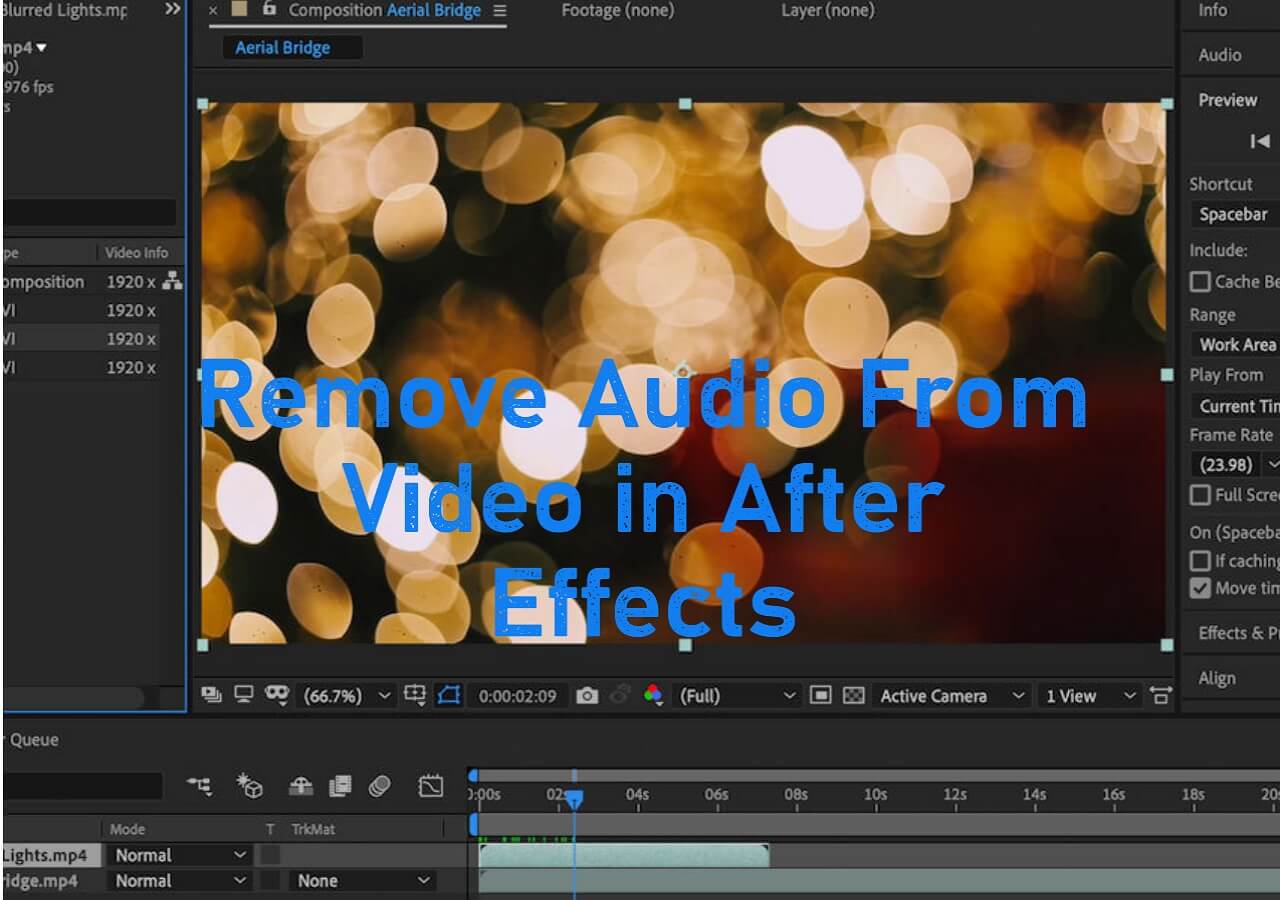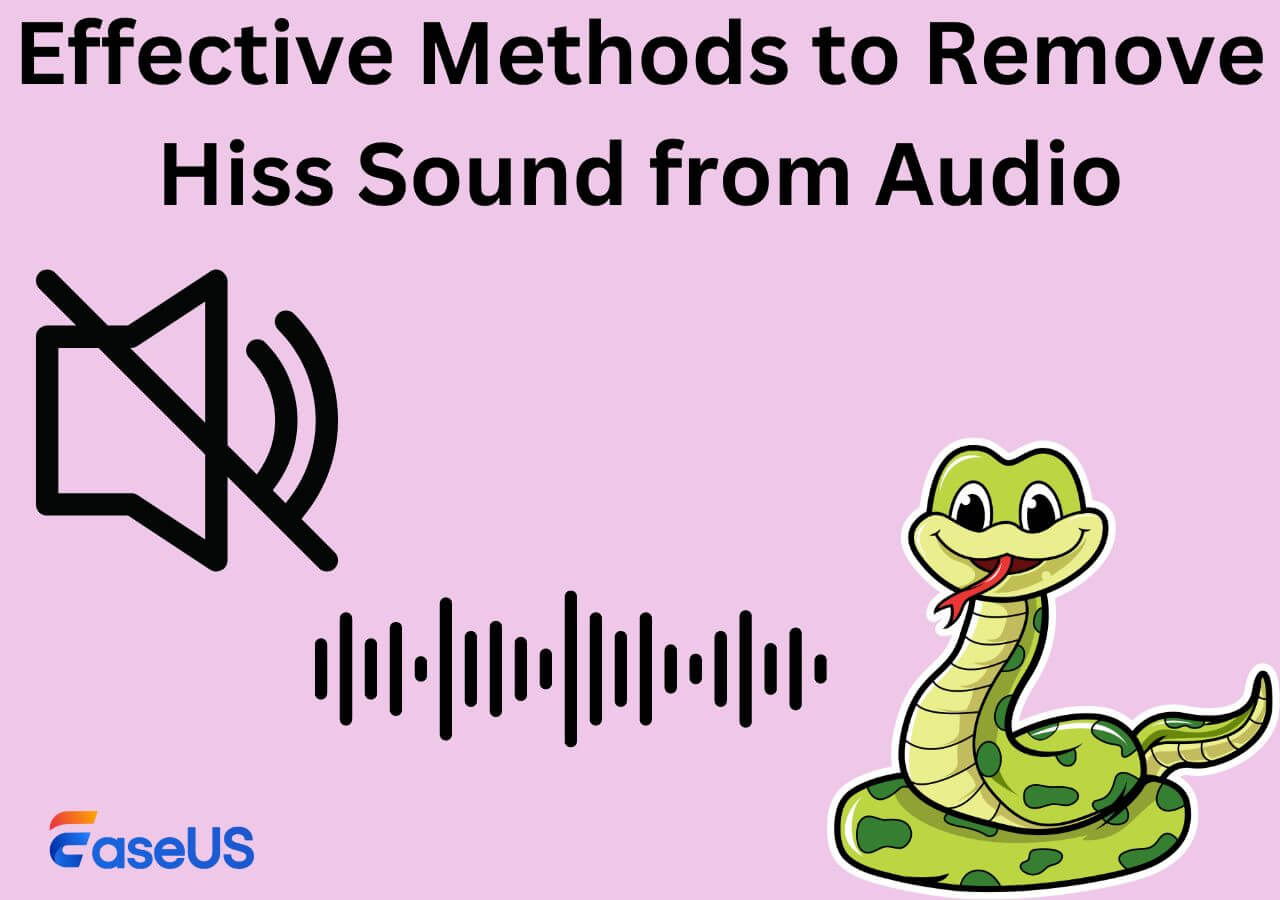-
![]()
Sofia Albert
Sofia has been involved with tech ever since she joined the EaseUS editor team in March 2011 and now she is a senior website editor. She is good at solving various issues, such as video downloading and recording.…Read full bio -
![]()
Melissa Lee
Melissa Lee is a sophisticated editor for EaseUS in tech blog writing. She is proficient in writing articles related to screen recording, voice changing, and PDF file editing. She also wrote blogs about data recovery, disk partitioning, data backup, etc.…Read full bio -
Jean has been working as a professional website editor for quite a long time. Her articles focus on topics of computer backup, data security tips, data recovery, and disk partitioning. Also, she writes many guides and tutorials on PC hardware & software troubleshooting. She keeps two lovely parrots and likes making vlogs of pets. With experience in video recording and video editing, she starts writing blogs on multimedia topics now.…Read full bio
-
![]()
Gorilla
Gorilla joined EaseUS in 2022. As a smartphone lover, she stays on top of Android unlocking skills and iOS troubleshooting tips. In addition, she also devotes herself to data recovery and transfer issues.…Read full bio -
![]()
Rel
Rel has always maintained a strong curiosity about the computer field and is committed to the research of the most efficient and practical computer problem solutions.…Read full bio -
![]()
Dawn Tang
Dawn Tang is a seasoned professional with a year-long record of crafting informative Backup & Recovery articles. Currently, she's channeling her expertise into the world of video editing software, embodying adaptability and a passion for mastering new digital domains.…Read full bio -
![]()
Sasha
Sasha is a girl who enjoys researching various electronic products and is dedicated to helping readers solve a wide range of technology-related issues. On EaseUS, she excels at providing readers with concise solutions in audio and video editing.…Read full bio
Content
0 Views |
0 min read
Ultimate Vocal Remover is so good I audibly said "holy moly" when I listened to what it produced. It recently released a full-band model (UVR-MDX-NET Inst HQ 1), unlike spleeter which has an 11kHz cutoff. I suggest you try it out, of course it's open-source.
--From Reddit
When it comes to separating vocals from background noise, Ultimate Vocal Remover is a powerful tool that can help you achieve professional-grade results. Whether you want to create karaoke tracks or remixes, this software provides an easy and efficient way to extract vocals from your favorite songs. Using Ultimate Vocal Remover is straightforward if you get the hang of it, and with just a few simple steps, you can transform your music into instrumental versions.
In this guide, we will walk you through the process of using UVR5 (Ultimate Vocal Remover 5), so you can make the most out of this versatile tool and unleash your creativity.
What Is Ultimate Vocal Remover?
Ultimate Vocal Remover is a powerful, open-source, and cross-platform tool that can separate vocals and instruments from audio files. All models provided in this package were trained by UVR core developers except for the Demucs v1, v2, v3, v4 4-stem, and 6-stem models. The latest version of UVR is v5.6.0.
The tool is available for Windows, macOS, and Linux distributions and supports multiple audio formats like MP3, FLAC, OGG, WAV, and FFmpeg-supported formats. With its AI-powered capabilities and easy-to-use interface, users can effortlessly separate vocals from music free and manipulate audio tracks to suit their needs. This facilitates creating karaoke versions, isolating instrumentals, and more.
Features
- Choose the export formats (WAV, FLAC, or MP3) for the output
- Import MP3, FLAC, OGG, WAV, and FFmpeg-supported formats
- AI-based vocal and instrument removal from audio tracks.
- Select the desired model for file separation
- Utilize GPU conversion with a powerful NVIDIA GPU
- Create a 30-second song sample for conversion assurance
- 🧑🎓User Review
- I was blown away by a new feature by BandLab that will separate a song into drums, vocals, bass, and instruments. I tried one song as a demo. The lack of artifacting was shocking. - By dwarfinvasion, from Reddit Community
How to Use Ultimate Vocal Remover GUI?
Now that you understand what Ultimate Vocal Remover GUI is, let's delve into the specific steps and best settings to utilize the UVR5 effectively. The whole process may take you 10-15 minutes.
Stage 1. Install Ultimate Vocal Remover 5
📃Prerequisite:
It's important to note that there are some requirements for operating systems and free storage space.
- System requirements: Windows 10 or later, macOS Catalina and above.
- Storage space: 3GB free disk space, at least
Step 1. Download Ultimate Vocal Remover 5
- For Windows and macOS: scroll down and download from GitHub.
- For Linux: download the repository.
Step 2. Install the tool
- For Windows and macOS: follow the instructions.
- For Linux:
Install the dependencies.
Debian/Ubuntu/Linux Mint: sudo apt update && sudo apt install ffmpeg python3-pip python3-tk git/em>
Fedora (enable RPMFusion repositories first): sudo dnf install ffmpeg python3-pip python3-tkinter git
Arch Linux/Manjaro: sudo pacman -S ffmpeg python-pip tk git
Clone the Ultimate vocal remover.
git clone https://github.com/Anjok07/ultimatevocalremovergui
Access the directory and install.
em>cd ultimatevocalremovergui
pip3 install -r requirements.txt
Launch the tool.
python3 UVR.py
Share this post on your social media with your net pals!
Stage 2. Remove Vocals from Audio with Ultimate Vocal Remover
Step 1. Open UVR 5 and choose the input and output locations.
Click "Select Input", the blank space next to it, or the folder icon to import the song, and click "Verify Inputs", then click "Select Output" to browse or create a destination folder. Select the output format below it.

Step 2. Select the process method for downloading models.
Choose "MDX-Net" from the dropdown list.
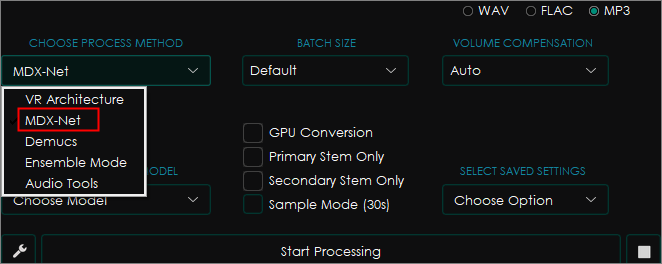
Step 3. Download more models from the "Choose Model" dropdown menu.
Click "Download More Models" > "VR Arch," "MDX-Net," and "Demucs" > "No Model Selected" > download the following models from the list. This could take minutes.
- VR Arc Single Model V5: 7_HP2 UVR
- MDX-Net: UVR-MDX-NET Inst 3
- MDX-Net: UVR-MDX-NET Inst Main
- MDX-Net: UVR-MDX-NET Main
- Demucs: V4 | htdemucs_ft
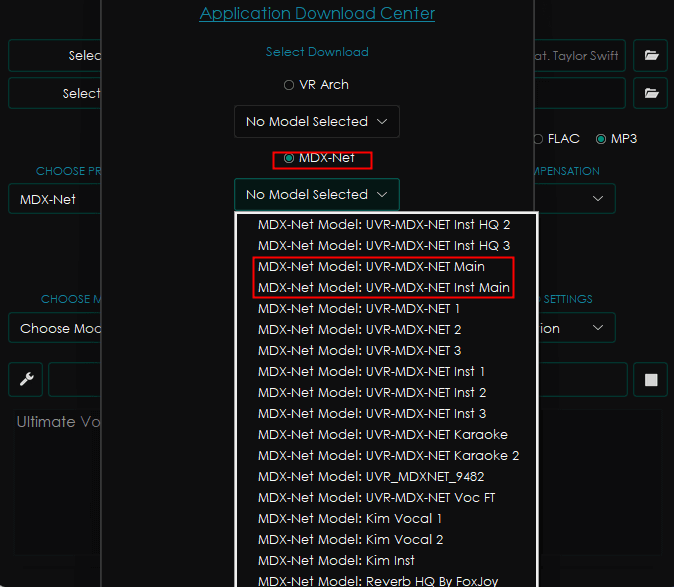
Step 4. Select the process mode to remove vocals.
- Choose "Ensemble Mode" > "MAIN STEM PAIR" > "Vocals/Instrumental" > "ENSEMBLE ALGORITHM" > "Max Spec/Max Spec."
- Select the downloaded models. Then "Choose Option" > "Save Ensemble" > name it > "Save."
- Enable the "GPU Conversion" and select "Vocal Only" or "Instrumental Only".
- Click "Start Processing".
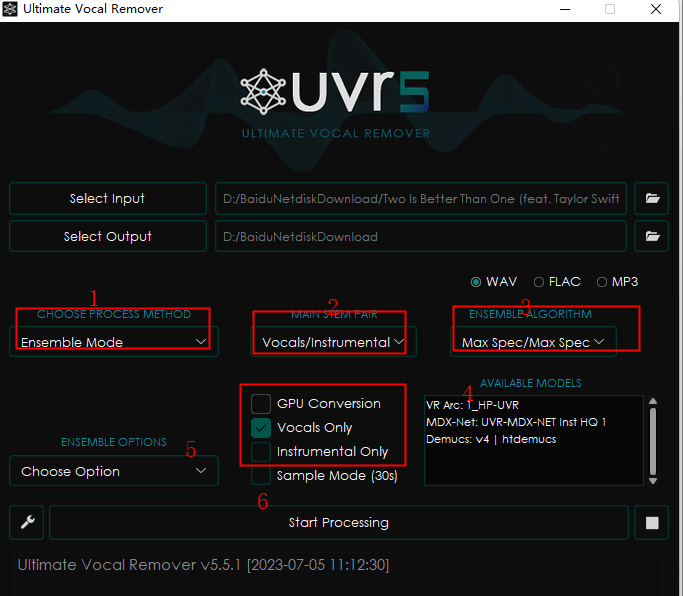
Watch the video tutorial if you want a visual presentation📺.
Key moments:
- 0:19 Download UVR 5
- 0:50 Download models
- 2:05 Use ensemble mode
- 3:42 Select input and output
- 4:08 Check everything and start processing
- 4:21 Play the song
- 6:23 Process another song
- 6:35 Play the second song

The Best Online Alternative to Ultimate Vocal Remover
Ultimate vocal remover is effective to separate vocals from background music. However, this whole procedure is tricky and time-consuming, and it also poses some challenges to your computer resources.
EaseUS Online Vocal Remover for PC is an easier and faster alternative to Ultimate Vocal Remover 5. It requires no downloading or installation and has a user-friendly UI for beginners. With an AI algorithm, this voice remover extracts vocals from a 3m40s song in seconds and allows users to download them respectively for karaoke.
It is completely free and supports MP3, WAV, AAC, AIFF, M4A, FLAC, and more formats. Besides, this vocal remover has a file limit of 350MB, and you can upload up to 1 hour of audio clips for separation.
Remove Vocals from Audio Using EaseUS Online Vocal Remover
Step 1. From the main page of EaseUS Online Vocal Remover, choose "Vocal Remover" from the left, and click "Choose file" to upload your video or audio files. You can also drop the file into the window.
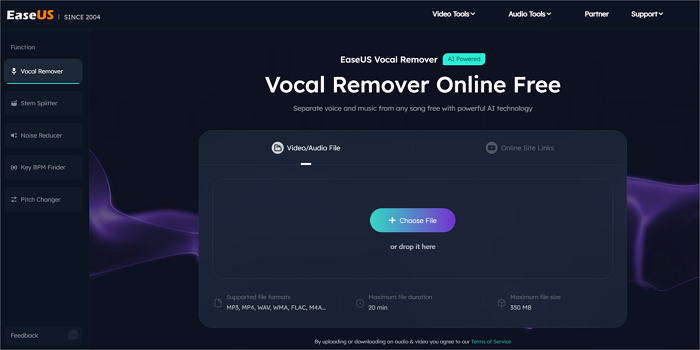
Step 2. By AI algorithm, all the vocals in the audio will be recognized automatically and then separated from the music in seconds.
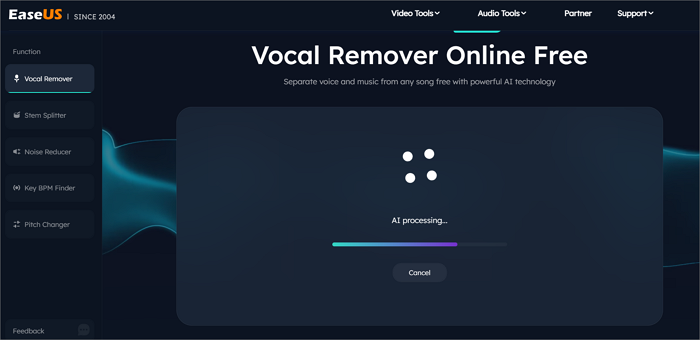
Step 3. Once vocals are extracted, audition the audio, and then choose to download the extracted Karaoke, instrumental sound, or background music.
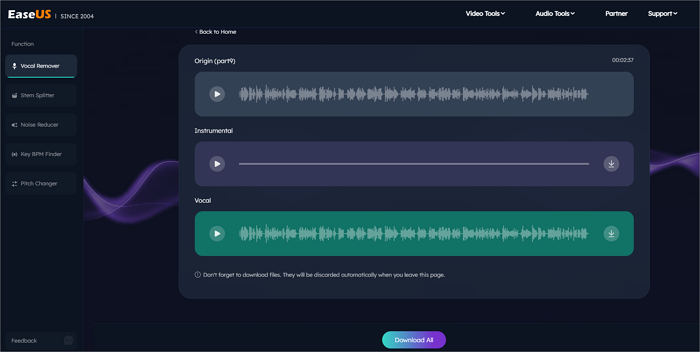
Final Thoughts
Ultimate Vocal Remover 5 is a powerful tool with customizable options to remove vocals from audio tracks. However, it has limitations in terms of hardware compatibility and operation difficulty.
For a faster and easier alternative, consider using EaseUS online vocal remover, which offers a comprehensive solution for vocal removal and separation.
Ultimate Vocal Remover FAQs
1. How does Ultimate vocal remover work?
Ultimate vocal remover can extract vocals and instruments from songs in MP3, WAV, or FLAC formats. Additionally, it allows the output to be exported in the same formats, thanks to the integration of FFmpeg.
2. How do you use voice remover?
To use a voice remover, you can follow these general steps:
- Choose a voice remover software or online tool.
- Import or upload the audio file.
- Select the vocal removal option.
- Adjust settings if available.
- Process the audio.
- Review and save the output.
3. Is Ultimate Vocal Remover free?
Ultimate Vocal Remover offers both free and paid versions. The free version is a good starting point for basic vocal removal needs, while the paid version provides more comprehensive tools and customization options for professional users or those with specific requirements.
4. How long do you have to wait for vocal remover?
The waiting time for vocal removal varies based on the tool and audio file complexity. It can range from seconds to minutes, depending on the specific software used. Take EaseUS VideoKit for example, this AI-powered tool takes 20 seconds to separate vocals from background noise for a 3m40s song.

